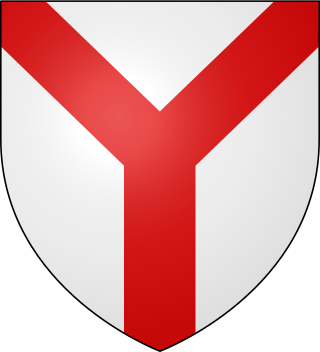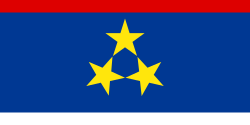Top Qs
Timeline
Chat
Perspective
Pall (heraldry)
Heraldic charge From Wikipedia, the free encyclopedia
Remove ads
A pall (or pairle) in heraldry and vexillology is a Y-shaped charge, normally having its arms in the three corners of the shield. An example of a pall placed horizontally (fesswise) is the green portion of the South African national flag.[1][2]




A pall that stops short of the shield's edges and that has pointed ends to its three limbs is called a shakefork, although some heraldic sources do not make a distinction between a pall and a shakefork.[3][2] A pall standing upside down is named pall reversed.[3]
An ecclesiastical pall on a shield, or pallium, is the heraldic indicator of archbishoprics.[2] These palls usually have a lower limb that stops short of the bottom of the shield with a fringe.[3]
Palls can also be modified with heraldic lines.[4] One example is the coat of Saint-Wandrille-Rançon,[5] displayed below (third). The wavy heraldic line on a pall can be used to represent a river, or a confluence thereof, as in the arms of Nigeria (the rivers Niger and Benue, which join at Lokoja).
A field may be divided into three parts, tierced per pall (or in pairle), resembling a combination of division per chevron and per pale.[6][7] Charges may be borne in pall, that is, arranged in a form resembling a pall.[8]
Remove ads
Gallery
- Arms of the Earl of Glencairn, chief of Clan Cunningham: Argent, a shakefork sable
- Arms of the town of Saint-Wandrille-Rançon:
Vert, a pall wavy Argent accompanied in chief by one mill wheel Or and flanked by two fleurs-de-lys of the same. - Arms of the city of Khabarovsk
- Coat of Arms of Otto von Bismarck (oak leaves in pall)
- Seal of Shanghai Municipal Council, Shanghai International Settlement
Flags with palls
Flags party per pall
Flags with charges in pall
- Flag of Tremp, Lleida, Catalonia, Spain
- Former house flag of the Hamburg Atlantic Line (1958-1973; 1991-1997)
- Flag of Oita Prefecture, Japan
- Flag of the Shanghai International Settlement
(flag escutcheons)
Remove ads
See also
References
External links
Wikiwand - on
Seamless Wikipedia browsing. On steroids.
Remove ads

























